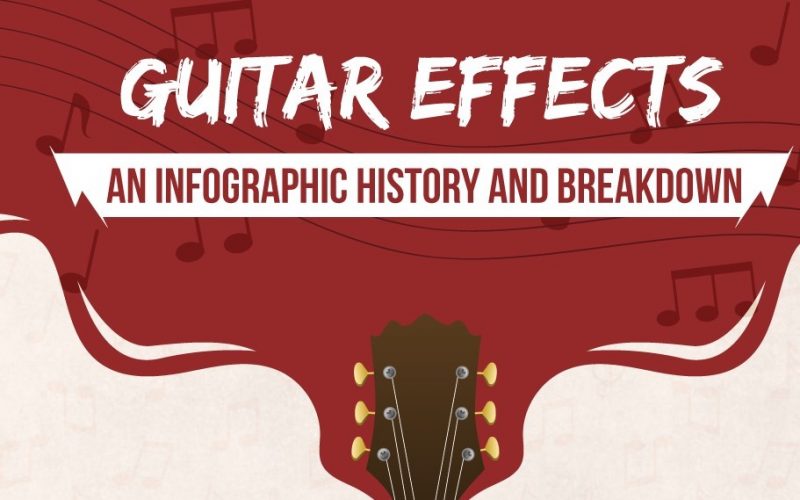1930s: The first effect came built into Rickenbacker’s Vibrola Spanish Guitar. It used a motorized pulley system to modify pitch, creating the first floating tremolo bridge.
1940s: Guitarists DIY-ed early effects, though most were only possible in the recording studio.
- Les Paul manipulated reel-to-reel tape to add echo effects.
- Duane Eddy created a studio reverb/echo chamber using a 500-gallon water tank outfitted with a microphone and speaker.

Share this Image On Your Site
By the late ’40s, amp makers started including gain and reverb, utilized by guitarists like Roy Orbison and Chet Atkins to make a “Slapback” effect.
- First tremolo amp: Gibson GA-50T and Premier ’66’ (1948)
- First spring reverb amp: EchoSonic (1950)
1946: Release of first commercial stand-alone guitar effect (Trem Trol 800 Tremolo).
- The guitar’s signal passed through a glass jar of electrolytic fluid. The pedal’s motor would shake the jar, making the signal fluctuate.
- Used famously by: Bo Diddley (“Diddley Daddy”, “Pretty Thing”), Muddy Waters (“Flood”)
1950s: Guitarists discover distortion (for the most part completely by accident).
- ’50s power chord master Pat Hare achieved distortion by turning the volume knob “all the way to the right until the speaker was screaming”.
- Link Wray reportedly stabbed a hole in his amp’s speaker for the distortion on “Rumble”.
- Willie Kizert (Ike Turner and the Rhythm Kings) found the first fuzz effect after dropping his Fender Bassman amp on a rainy street, blowing a tube.
1956: First intentional guitar distortion attributed to a 1956 recording from Johnny Burnette’s Rock ‘n Roll Trio.
- Marshall Amplification soon followed with the Marshall 1963, the first amp to intentionally produce distortion.
In the late ’50s and early ’60s, stand-alone effects gained popularity. Powered by vacuum tubes, they were bulky, expensive, and fragile, limiting their use
- Gibson GAV-I: first popular stand-alone vibrato
- Fend Reverb Box: first popular stand-alone reverb (released 1961)
- Watkins Copicat: first portable tape echo effect (released in 1958, popularized by The Shadows)
1960s: The first transistor-powered pedals hit the market. Cheaper, lighter, and more stable, these pedals made effects available to more players
- Maestro Fuzz Tone, 1962: marketed by Gibson, made famous by Rolling Stones (“Satisfaction”)
- The Clyde McCoy, 1967: First wah-wah pedal, made by Warwick Electronics
- Octavio, 1967: First octave effect, Named by Jimi Hendrix and made by Jim Morris of Kelsey-Morris Sound
- Uni-Vibe, 1968: marketed by Univox and based off the Leslie rotating speaker, made famous by Jimi Hendrix
1970s: Effects pedals skyrocketed in popularity. The options expanded and solidified into the basic categories you’ll still find today:
Signal alterations: Narrows or expands the signal’s tone or level
- Boost: raises signal level
- Compression: narrows tone range
- Volume: Pedal volume operation for swells and fades
- Noise gate: Hides sound going into amp when guitar is silent
Distortion: Mimics the sounds of damaged or overdriven vacuum tubes
- Overdrive: sound of tube amps pushed to their limit
- Fuzz: Replicates buzzy tone of a busted vacuum tube
- Digital distortion: alters waveform and boosts levels
Modulation: Changes the pitch or frequency of the signal
- Vibrato: Quick, subtle pitch changes (can be produced manually using whammy bars)
- Tremolo: Quick, subtle dynamic changes
- Octave: Signal output up or down an octave
- Phaser: Signal is split and played back at different wavelengths
- Flange: More sweeping form of phaser
- Ring modulator: Signal is split and internal oscillator makes math-based alterations
Time-based effects: Duplicates original signal, often with modifications
- Echo: Adds echo to signal
- Reverb: Multiple echoes with different decay rates emulates sense of space
- Chorus: Signal duplicated and slightly detuned to sound like multiple players
- Delay: Signal played back after short pause
- Reverse delay: Signal reversed then played back
- Loop: Full phrases recorded and layered
Filter Effects: Alters select frequencies
- Equalizer (EQ): Boost or low specific frequencies or ranges
- Wah-Wah: Filter or compress select frequencies to create crying sound
- Envelope filter: Folds sound back on itself
- Talk box: Links guitar sound to vocals


